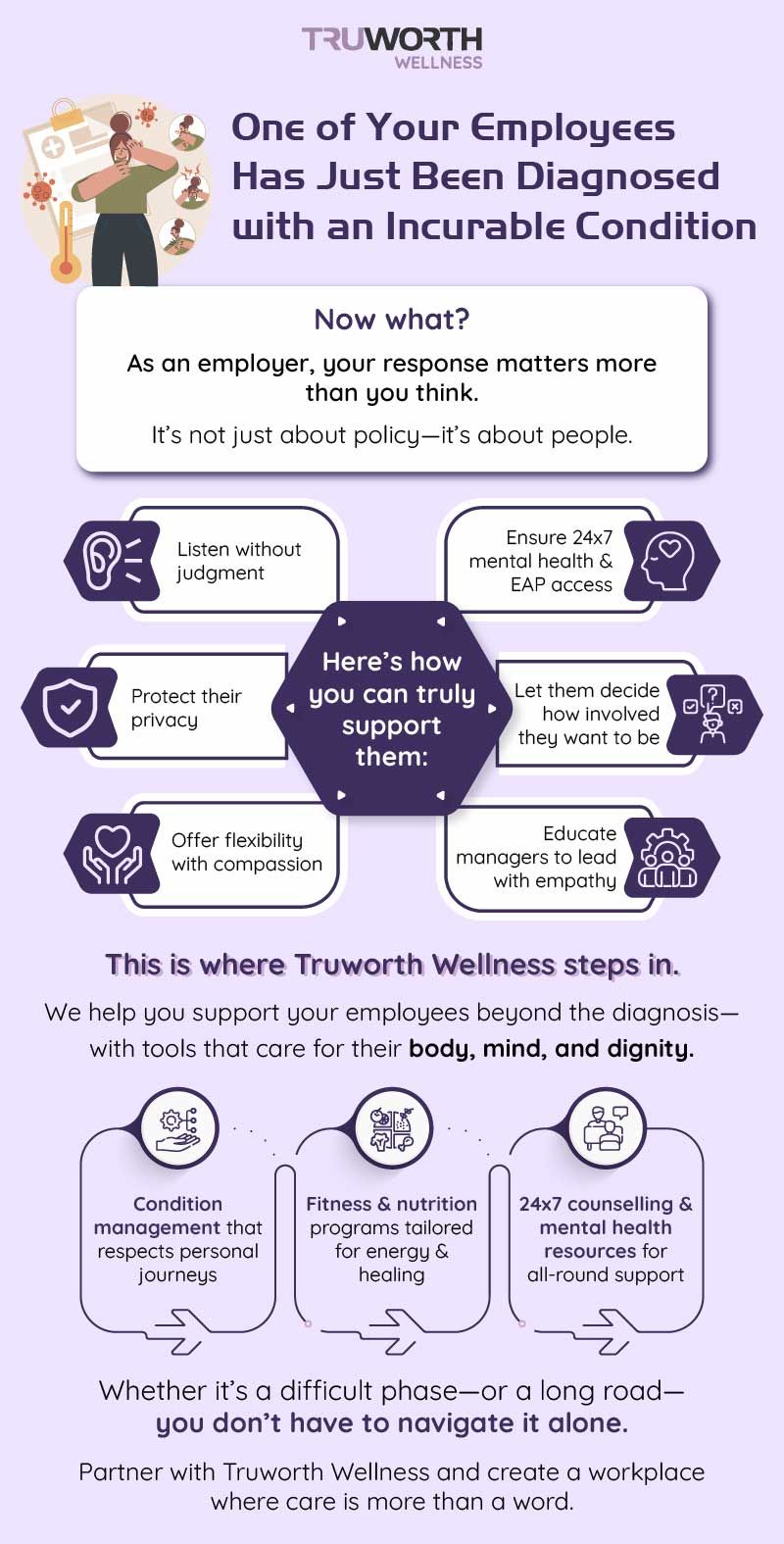Supporting An Employee With An Incurable Condition: A Guide For Employers

As employers, we often prepare for performance reviews, market shifts, and project deadlines, but rarely do we prepare for the emotional and human challenges that arise when an employee is diagnosed with an incurable condition.
- How should you, as a leader or HR manager, respond?
- How do you balance empathy with business needs?
- How do you build a support structure that truly helps, without overstepping or isolating the person involved?
These are tough, emotional questions—and they deserve thoughtful answers.
This blog aims to serve as a compassionate, practical guide for employers who want to do the right thing when one of their team members is facing a life-changing health diagnosis.

1. Start with Sensitivity and Confidentiality
When an employee informs you of their diagnosis, the first priority is confidentiality. Even if the intention is to help, sharing the news without their consent is a breach of trust and privacy.
Create a safe and confidential environment for them to express what they’re comfortable sharing. Ask:
- “Would you prefer to keep this private or are you open to us informing certain team members?”
- “How can we best support you during this time?”
Let them lead the tone and extent of disclosure.
2. Be Flexible with Work Arrangements
Chronic or incurable conditions can affect energy, concentration, pain levels, and more. Traditional 9-to-5 structures may no longer work.
Consider offering:
- Remote or hybrid work options
- Flexible hours or reduced workload
- Additional sick leave or wellness days
- Long-term leave planning, if needed
Small adjustments to their work life can help them feel respected and supported, not penalized for their health.
3. Educate Managers and Team Leaders
Empathy should not just sit in the HR department—it should extend across leadership. Hold sensitization workshops or leadership sessions to:
- Educate managers about how to support employees with serious health conditions
- Address unconscious bias
- Emphasize language, respect, and boundaries
- Reinforce that performance expectations may need to be adapted, not lowered
When managers lead with compassion, team culture follows.

4. Offer Counseling and Wellness Resources
A diagnosis doesn’t just affect the body—it impacts mental and emotional well-being. It also affects colleagues and teams who may be feeling unsure, helpless, or even emotionally overwhelmed.
This is where a robust wellness partner can make all the difference.
Ensure employees have access to:
- 24x7 EAP counselling support
- Mental health resources
- Condition management support across health, fitness, and nutrition
- Regular wellness check-ins
Normalize the use of these services. Lead by example and remind teams that asking for help is a strength, not a weakness.
5. Respect Their Contribution and Autonomy
One common mistake is to make overly generous assumptions, like excluding the employee from key projects, thinking you're helping them “rest.” But what may seem like compassion can feel like professional exile to them.
Instead:
- Ask if they’d like to stay involved in ongoing projects
- Let them decide how much or how little they’d like to take on
- Recognize their contribution, not just their condition
Give them dignity by trusting them to navigate their work based on their abilities—not assumptions.
6. Plan for Long-Term Support, Not Short-Term Sympathy
Supporting an employee with an incurable condition is not a one-time gesture. It’s a long journey that might require multiple touchpoints.
Keep the conversation open by:
- Scheduling quarterly wellness reviews (not just performance reviews)
- Checking in even when the health updates slow down
- Offering continuity in support, whether they stay with the company or need to transition out gracefully
Support isn’t about flashy moments—it’s about consistent care.
7. Enable a Culture of Support Among Colleagues
Sometimes, the most meaningful support doesn’t come from the top, but from peers. However, team members may not know how to respond or interact with someone going through a serious illness.
Help employees by:
- Hosting informal sensitization sessions
- Sharing guidelines on empathy, inclusion, and what not to say
- Appointing a wellness or HR buddy to coordinate communication (if the employee consents)
The goal isn’t to single anyone out—it’s to make sure no one feels alone.
8. Handle Performance Conversations with Grace
Yes, business goals still matter—but it’s crucial to shift the way performance is reviewed in such scenarios. Don’t tie their value to their output during a time of personal health crisis.
Instead:
- Focus on meaningful contribution, not volume
- Use a gentle, collaborative tone during performance check-ins
- Be prepared to make accommodations based on current ability
Compassion and professionalism can co-exist. In fact, they must.
9. Support for When Transitions Are Needed
Sometimes, the condition may progress to a point where the employee chooses to step away temporarily or permanently. Your role here is to ensure that the exit—if it comes—is handled with grace and respect.
Offer:
- Personalized transition planning
- Clear guidance on medical and financial benefits
- Farewells that celebrate, not mourn, the person’s journey
The way you handle exits speaks volumes about your company’s values.
10. Partner with Wellness Experts Like Truworth Wellness
At Truworth Wellness, we help organizations navigate these sensitive challenges with empathy, structure, and real solutions. Our Condition Management Programs address all aspects of health—from physical and nutritional wellness to fitness and stress resilience.
Our mental health resources and 24x7 EAP counselling support provide safe, confidential care for employees dealing with chronic illnesses, stress, burnout, or emotional distress. We also assist HR and managers with wellness training, digital tools, and crisis support frameworks.
Let us help you build a workplace where care isn’t just a tagline—it’s a practice.
[Reach out to Truworth Wellness] to activate a culture of proactive, compassionate wellness at your organization.
Conclusion
Being an employer in today’s world means more than managing payroll and productivity—it means showing up for people, especially during their most vulnerable moments.
Supporting an employee with an incurable condition isn’t just the “right thing to do”—it builds loyalty, fosters trust, and defines your workplace culture in ways that outlive quarterly targets.
In a world where businesses strive to become more human-centered, this is your chance to lead by example.
Let empathy drive your decisions. Let respect shape your responses. And let real, ongoing support be your legacy.
